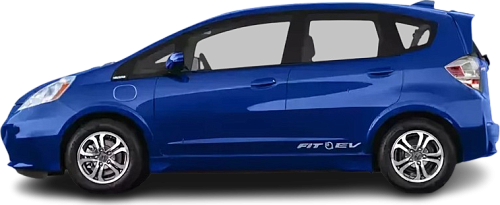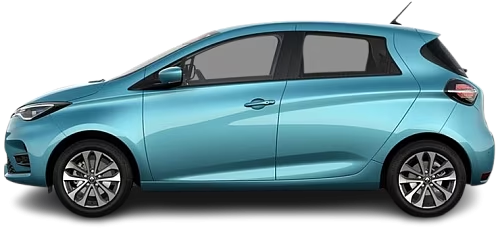Global EV Comparison: Honda Fit EV Gen 1 vs Renault Zoe Z.E. 50 R135
Struggling to Decide? Let AI Help!
Your AI Summary Is Ready!
General Info
Since both vehicles have been discontinued, they are now only available on the used car market. You can get the Renault Zoe Z.E. 50 R135 (2019-2024) for as low as €9950, while the Honda Fit EV (2013-2015) was never offered for sale in Europe.
The two vehicles share the same body style: Hatchback.
| Property | Honda Fit EV Gen 1 | Renault Zoe Z.E. 50 R135 |
|---|---|---|
| Years of Production | 2013-2015 | 2019-2024 |
| Current Status | Discontinued | Discontinued |
| Country of Manufacture | USA | France |
| Body Style | Hatchback | Hatchback |
| Market Availability | USA | EU |
| Price Europe (Used) | - Price Europe (Used) | €9950 |
| GCC Score | 3.9 | 5.6 |
Range and Efficiency
While the Renault Zoe Z.E. 50 R135 (2019-2024) offers a longer real-world range and a bigger battery, it is less energy-efficient than the Honda Fit EV (2013-2015).
| Property | Honda Fit EV Gen 1 | Renault Zoe Z.E. 50 R135 |
|---|---|---|
| Range (EPA) | 132 km | - Range (EPA) |
| Range (WLTP) | - Range (WLTP) | 385 km |
| Range (GCC) | 125 km | 327 km |
| Battery Capacity (Nominal) | 20 kWh | 54.7 kWh |
| Battery Capacity (Usable) | 19 kWh | 52 kWh |
| Efficiency per 100 km | 15.2 kWh/100 km | 15.9 kWh/100 km |
| Efficiency per kWh | 6.58 km/kWh | 6.29 km/kWh |
| Range and Efficiency Score | 5.4 | 6.5 |
Charging
Both vehicles utilize a standard 400-volt architecture.
The Honda Fit EV (2013-2015) has no DC fast charging capability, whereas the Renault Zoe Z.E. 50 R135 (2019-2024) can charge at up to 50 kW.
The Renault Zoe Z.E. 50 R135 (2019-2024) features a more powerful on-board charger, supporting a maximum AC charging power of 22 kW, whereas the Honda Fit EV (2013-2015) is limited to 6.6 kW.
| Property | Honda Fit EV Gen 1 | Renault Zoe Z.E. 50 R135 |
|---|---|---|
| Max Charging Power (AC) | 6.6 kW | 22 kW |
| Max Charging Power (DC) | - Max Charging Power (DC) | 50 kW |
| Architecture | 400 V | 400 V |
| Charge Port | Type 1 (J1772) | CCS Type 2 |
| Charging Score | 2.7 | 6.9 |
Performance
Both vehicles are front-wheel drive.
Although the Renault Zoe Z.E. 50 R135 (2019-2024) has more power, the Honda Fit EV (2013-2015) achieves a faster 0-100 km/h time.
| Property | Honda Fit EV Gen 1 | Renault Zoe Z.E. 50 R135 |
|---|---|---|
| Drive Type | FWD | FWD |
| Motor Type | PMSM | EESM |
| Motor Power (kW) | 92 kW | 100 kW |
| Motor Power (hp) | 123 hp | 134 hp |
| Motor Torque | 256 Nm | 245 Nm |
| 0-100 km/h | 8.4 s | 9.5 s |
| Top Speed | 140 km/h | 140 km/h |
| Performance Score | 2.7 | 2.5 |
Dimensions
The Renault Zoe Z.E. 50 R135 (2019-2024) boasts a more extended wheelbase.
| Property | Honda Fit EV Gen 1 | Renault Zoe Z.E. 50 R135 |
|---|---|---|
| Length | 4105 mm | 4087 mm |
| Width (with Mirrors) | 1694 mm | 1945 mm |
| Width (w/o Mirrors) | - Width (w/o Mirrors) | 1787 mm |
| Height | 1524 mm | 1562 mm |
| Wheelbase | 2499 mm | 2588 mm |
Cargo and Towing
Neither car is equipped with a frunk (front trunk).
Neither vehicle is officially rated for towing in in the EU.
| Property | Honda Fit EV Gen 1 | Renault Zoe Z.E. 50 R135 |
|---|---|---|
| Number of Seats | 5 | 5 |
| Curb Weight | 1475 kg | 1577 kg |
| Cargo Volume (Trunk) | 340 l | 338 l |
| Cargo Volume (Max) | - Cargo Volume (Max) | 1225 l |
| Cargo Volume (Frunk) | - Cargo Volume (Frunk) | - Cargo Volume (Frunk) |
| Towing Capacity | - Towing Capacity | - Towing Capacity |
| Cargo and Towing Score | 4 | 4.2 |




